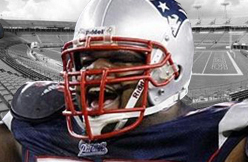PHOENIX -- Newton’s Third Law: When one body exerts a force on a second body, the second body simultaneously exerts a force equal in magnitude and opposite in direction.
Newton’s Third Law? Rickey Bethel begs to differ. Don’t worry; you’re not supposed to know who Rickey Bethel is. He’s a campus policeman at Florida Atlantic University, if you were wondering, but today we are concerned only with what he was. Back then, 16 years ago, Bethel was a scrawny, 130-pound high schooler, the quarterback-in-waiting at Santaluces High in Lantana, Fla. As a freshman, Bethel made varsity, with the expectation he’d start a year later. He was talented, and one teammate took it upon himself to make sure he was ready.
That teammate was Vince Wilfork, Vince Wilfork before Miami, before the Patriots, before the Super Bowls. The junior defensive tackle (and offensive lineman, and occasional punter, but we’ll get to that a bit later) had known Bethel and his family for years, and he looked at the young quarterback like a little brother. He saw his talent, thought he was the player his team needed at quarterback, and so he decided to send each of his close to 300 pounds flying at Bethel. Once, twice, dozens of times over the course of his freshman season, the quarterback was pancaked out of the blue.
“It was crushing,” Bethel recalls, laughing. “I used to just keep a smile on my face. I always would try to make it feel like it didn’t hurt as much."
And so he would crumple. “When I saw him coming,” Bethel explains, “usually I would just go with it.” There was no equal and opposite force. There was only giving in; to take a hit from Wilfork -- who has the highest BMI of any player in this year’s Super Bowl -- is to think only of survival. It is to bend, to scrunch, to fold. This is the physics of pain.
You see, even when Wilfork was an eighth grader, his frame dropped jaws. His high school coach, Ray Berger, recalls the hype during the spring before Wilfork hit high school; even his father, David, had a brag or two to share with the coach, but Berger discredited it all. This was just a case of too-proud parents, he thought, and kids prone to hyperbole. And then Wilfork showed up to play.
He weighed about 255 pounds at the time, Berger says, and the coach recalls the teenager resembling a grown man. “He just had the broad shoulders, the thickness,” Berger explains. “He had a baby face, but other than that, everything was solid.”
By his senior year, Wilfork played nearly every role he could. He took snaps on offense and defense, convinced his coach to let him punt -- an errant snap and Wilfork lumbering after the loose ball ended that experiment quickly -- and was the unofficial team motivator. That’s why he wouldn’t stop hitting Bethel, not even after he ascended to the starting job, not even when Berger told him to cut it out. That’s how he found himself wrestling his brother during an intersquad scrimmage.
He wanted his teammates to be the best. He wanted to test them, to stretch their limits.
He didn’t want them to crumble. He wanted them to push back.
--
Momentum is mass in motion, an object’s mass times its velocity.
If a man can be reduced to physics, then that is Wilfork: some 325 pounds of mass in the most surprising of motion. He’s older now, 33, and slower after tearing his Achilles a season ago, but the things that made the five-time Pro-Bowler into the anchor of this Patriots' defense over the past decade remain in his repertoire. He fills gaps. He can handle multiple offensive players at once, freeing up teammates for mismatches, and unlike most men of his (immense) size, he’s no slouch at running down a quarterback. He’s still catlike in his responses and footwork, too; talk to any teammate or coach, past or present, about Wilfork, and that is the adjective they hold in common for this elephant of a man.
“A lot of guys can make tackles and make plays at the point of attack, right on somebody,” Butch Davis, who recruited Wilfork to Miami, says. “But [guys like Vince], you’d see these guys making tackles on the sidelines.”
Just ask Mike Tolbert about momentum. He’s the Chargers fullback who tried to haul Wilfork down after a 2011 interception. He wasn’t fast enough -- despite being four years younger and 80 pounds lighter -- and found himself flung to the sideline as Wilfork cruised into the end zone.
Or ask Darren McFadden, who two weeks later got the same treatment. The Raiders running back managed to get ahold of his target, as much as any two arms can grasp around perhaps the NFL’s girthiest posterior, but that wasn’t enough to bring Wilfork down. He gained another seven yards with McFadden waving behind him in the wind.
It’s momentum, too, that has brought Wilfork here, to the end of his 11th season, to what he hopes will be his second Super Bowl victory. It’s been a decade since the last, after his rookie year, when the Patriots squeaked by the Eagles, 24-21. Only two players remain from that championship team: Wilfork and Tom Brady, and this week, hours will be devoted to chewing on the dynasty Brady and Bill Belichick have built. The quarterback will smile and the coach will grunt paragraphs from your sixth-grade science textbook, and Wilfork, he’ll just sit at his podium, smile, talk about his children and his wife and the woman he pulled out of a wrecked car two weeks ago. Ho-hum.
But to take Wilfork for granted would be remiss. In fact, to talk about Brady and Belichick without even a mention of the team’s second longest-tenured player is to ignore the defense that’s kept the Patriots playing into February in four of Wilfork’s 11 seasons. “Vince is just as important as Brady,” former Patriots running back Corey Dillon says, and he just might be right.
Although New England’s reputation in recent years has been more focused on Brady’s arm and the aura of Gronk, it’s not been long since the Patriots had the fourth-best defense in the league. That was 2007, the 16-0 campaign and the second year in a stretch during which Wilfork and company ranked sixth, fourth, 10th and 11th in total defense. They weren’t the best unit in the NFL, but with offenses like the Patriots posted over that stretch, their defense did more than enough to keep them perennial Super Bowl contenders.
Then came 2013. New England’s defense had been wavering, and when Wilfork tore his Achilles in September, things devolved. The unit finished the year ranked 26th in total yards and 30th against the run, marking just the second season since Wilfork’s rookie season that the group had not finished in the top half of the NFL in run defense.
This season, though, the Patriots are back. Their star defensive tackle’s prime might be behind him, but he’s healthy, and New England’s defense finished 13th in total yardage, ninth against the run. On the season, Wilfork logged 19 quarterback hurries, 39 tackles and a sack in his return. The numbers aren’t what they were even three years ago, but on a team full of Super Bowl first-timers, Wilfork’s experience will count for nearly as much as his hits in the leadup to Sunday’s game.
“To get to this point and be able to have a chance to become a world champion, I mean, it’s special,” Wilfork says. “You have to do everything in your willpower to make that happen.”
“Nothing is given to you,” he adds a day later. “Everything you do you have to earn. There’s a price to pay for everything. … Sometimes I do things that might be impossible, and I find it out the hard way. Nothing wrong with trying.”
--
Newton’s First Law: Objects will remain in their state of motion unless a force acts to change the motion.
Gibraltar. It’s the giant rock that juts out of the sea south of Spain, and it’s the first word that drawls out of Davis’ mouth. What does Wilfork mean to the Patriots? He’s Gibraltar, this prehistoric beast of a rock, wide and tall, historically impossible to overtake, decidedly not in anything approaching motion. It’s as if it’s been there since the beginning of time, just as it’s a study in ancient history to recall Wilfork before his Patriots uniform.
“They just kind of built around him,” Davis continues, and he’s right. To consider Wilfork on the field is to speak of his surprisingly nimble movements and the speed that defies his size, but in a more meta sense, the defensive tackle’s career has been marked not by movement, but by standing still. Unlike many big-name Patriots before him, he has not moved on, although he came close last spring, when he reportedly asked for his release before restructuring his deal. Still, team and tackle have always been able to agree on a price tag, and over time the Patriots became the force that changed the motion, that said, no, stay here, be our rock.
It’s been more than 12 years since Wilfork’s parents passed away, but he continues to speak of them often, of the values they instilled. He takes “family first” to a new level, even offering parenting tips to some of his coaches, tips he undoubtedly learned from his own mother and father. David Sr. attended almost every one of his son’s high school practices despite battling kidney disease, and over time, he became the unofficial team dad. He’d drive anyone who needed a ride home in his minivan, and the Wilfork household was always a place to stop for water or snacks. When David Sr. passed away in 2002, his relationship with his son’s team remained so close that Berger spoke at his funeral.
And so it’s no shock that Wilfork assumed the role he has on the Patriots. If he isn’t the team dad, then he’s certainly the defense’s father figure, and though he may not speak in quantity, the advice he does give in his booming undertone is of the must-heed quality.
“He’s direct,” former teammate Jarvis Green says. “He knows what he has to do. He knows what he wants. He’s got that voice, that when he wants something done, he speaks.”
Patrick Graham, the Patriots linebackers coach who coached the team’s defensive line in 2012 and 2013, is only two years older than Wilfork, and he admits that to claim he’s made Wilfork a better player would be remiss. Really, he says, Wilfork made him a better coach. If the veteran didn’t like a play he’d installed, he’d never question Graham in front of other players. Instead, he’d wait until the meeting ended and his teammates had dispersed, and he’d offer his opinion. Graham, more often than not, would defer.
And then there were the film sessions. To teach young players their positions, teams show highlights of the best. Look at this Hall of Famer, look at his speed, his cuts, how he reads this offense. Explanation is often necessary, but not when Graham coached the defensive line. No, he’d just pop in the tape, let the action unfold, and if his players had questions, they could turn to its star. They were watching Wilfork, after all.
By now, though, the highlight reel may be complete. To play at an elite level after an Achilles injury and at Wilfork’s age is no small feat, and if the Patriots are going to get their rock one final ring, this is their best chance. Just don’t tell Wilfork; for as much as he concedes his football mortality, he refuses to regress to expectations. A year ago, he read the studies about players returning from Achilles injuries at his age and size. The results: not pretty. But that didn’t matter, didn’t affect his mindset as he launched into rehab and planned his path back. The science was irrelevant.
“Sometimes,” Wilfork concedes. “I tell people I’m not human.”
And so the body set in motion crushes all other forces. It moves and yet is still. It defies physics, but if Vince Wilfork isn’t human, do physics even apply?

(si.com)



